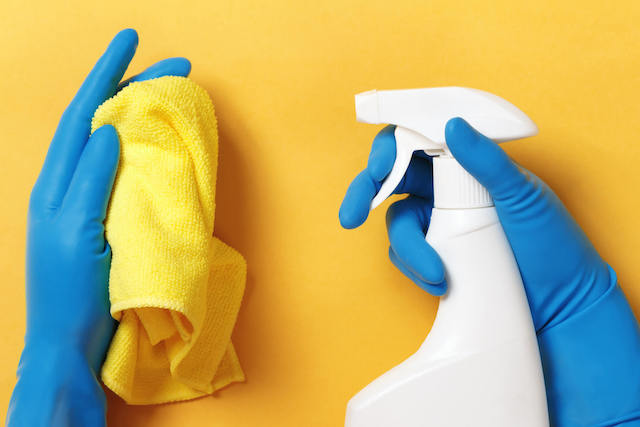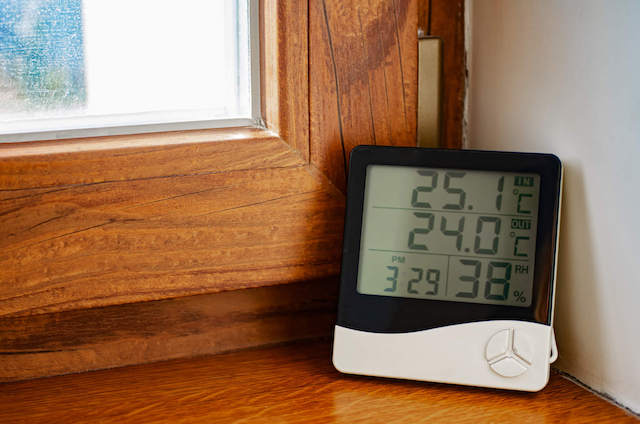Indoor air conditioning may be one of the best inventions of the modern world. It might be a stifling 102℉ outside, but inside? A tranquil and crisp 68℉, or whatever that personal ideal temperature is. An increasingly common tool to achieve this cool indoor temperature is the window AC unit. Like any good thing, though, there are potential issues that can pop up while using these phenomenal machines. One of the main problems that can pop up is mold in a window AC unit.

Whether renting an apartment or just trying to save money on electrical bills during those extra hot summer months, this unit is a phenomenal way to keep that indoor temperature low. However, without proper care, mold in a window AC unit can quickly turn this machine into a contamination nightmare. Once this fungus among us settles in, the machine may be blowing crisp, cool air into the indoor space, but it’s air that is filled with harmful microscopic particles.
That’s probably not exactly the result hoped for when installing one of these units, which is why it’s important to understand what to do should mold in a window AC unit occur and how to prevent it from popping up in the first place. Otherwise, the indoor environment could become a toxic space that does not support ongoing health.
Here’s everything you need to know.
Why There’s Mold in a Window AC Unit
Understanding the why of mold in a window AC unit is best accomplished by understanding the how. That involves delving into what exactly mold is and why it loves these machines.
Mold 101
Mold is a type of fungus with over 100,000 species identified so far. Each species reproduces by creating microscopic spores that they release into the air.¹’² This little tidbit is one of the key factors that leads to mold in a window AC unit. Thanks to their incredibly small size, these little particles will fly wherever the wind takes them, whether that’s through a forest or straight into the front door of a home.
The good thing is that these spores will remain non-living particles until they land on a habitable surface. It’s similar to how a plant produces seeds; those seeds remain seeds until they’re planted in soil and given the components they need to transition into a living plant. Likewise, a spore will remain a spore until it’s given the components it needs to transition into a living mold colony.
Thanks to the hardy nature of these little spores, they only need four aspects to transition into the world of the living.³
These four components are:
- Oxygen: this barely counts, which is why mold can grow inside walls
- Temperature: 40-90℉ is preferred but some species can live in the extremes (hence, mold in the fridge)
- Food: they’re like raccoons, they eat almost everything
- Moisture: the key ingredient
Mold in the Home: An Indoor Environment Fiasco
There’s a popular misconception that since mold is everywhere, it’s no big deal if it’s in our home. That’s false.
Sure, there are mold spores everywhere, but they’re dispersed throughout the big, wide world out there. Once colonized mold develops in a home, those particles it releases are no longer scattered throughout nature; they’re trapped within the walls of the home like a contaminated snow globe. One contributor to this is modern building trends. By creating homes with net-zero energy efficiency in mind, there’s very little airflow between the indoor and outdoor environments.
So, technically, mold is everywhere that it is growing because the colony continually releases those spores into the surrounding environment.

Think of it as a confetti cannon at a major sports event. The longer that mold grows, the higher volume of particles that will build up within those walls. To make matters worse, some species of mold also produce microscopic toxins called mycotoxins when they feel threatened, adding even more particles to that indoor space.⁴
No one wants to live in a particle-filled snow globe, which is why avoiding mold in the home is so important. One of the best ways to do this is to ensure mold in a window AC unit does not occur.
Why is there Mold in A Window AC Unit?
Mold in a window AC unit can develop in a few ways. The main contributing factors are whether there’s a water and food source inside of the machine.
Like any item in a home, dust and other organic matter can settle inside of the machine, offering up plenty of edible options for a lucky mold spore. As for moisture, this can occur due to various situations.
A few include:
- Condensation forms as the cool air from the machine hits the warmer air in the home
- High humidity can lead to condensation on the coils or interior of the machine
- Faulty or malfunctioning pieces of the machine can lead to a buildup of moisture
If the food and moisture boxes are ticked for 24-48 hours and a lucky spore stumbles upon the machine, it can quickly lead to mold in a window AC unit. Once established, that colony will start releasing spores into the air, which will then get blown all throughout the room. Due to their small size, they can also make their way into other areas of the home, whether that be the next room over or all the way downstairs.
As the particles continue to build up, they decrease the indoor air quality, contaminate whatever surfaces they come into contact with, and overall create a health nightmare.
Is Mold in Window AC Unit Dangerous?
The short answer is that yes, it can be dangerous. Mold exposure affects everyone differently, though. Researchers are still attempting to determine exactly how this indoor contaminant affects health, but it’s a tricky subject to nail down. Factors such as genetics, species of mold, the presence of mycotoxins, immune system status, and length of exposure all play a role.
Mold’s ability to affect health largely rests on the size of the particles in question. Measured in a unit called microns, mold spores and mycotoxins are so small that they’re able to make their way into our bodies. To put it into perspective, a micron is one one-thousandth of a millimeter, meaning you’d have to line up 1,000 microns to equal the distance between those two tiny lines on a ruler. The EPA classifies these types of particles as particulate matter and further breaks them down into two categories.⁵
These two categories are:
- PM10: particles that have a diameter of around 10 micrometers or less.
- PM2.5: fine particles that have a diameter of around 2.5 micrometers or less.
As stated above, it’s impossible to completely avoid exposure to a few of these particles throughout the day. Typically, when this situation occurs, the body’s immune system will surround the particles and get rid of them ASAP. Mold in a window AC unit doesn’t just lead to exposure to a few particles, though. Every time someone inside the home takes a breath of air, particles continually make their way inside the body, forcing the immune system to face an army of foreign invaders. This can lead to the immune system getting run down or malfunctioning, all of which lead to a long list of potential symptoms as toxicity builds up within the body. ⁶’⁷’⁸’⁹’¹⁰

Some of the symptoms of mold toxicity include:
- Runny nose
- Sore throat
- Digestive issues
- Rashes
- Hair loss
- Neurological issues
- Mood swings
- Respiratory problems
- Brain fog
- Chronic fatigue
Again, everyone responds differently to exposure. One person in the home may come down with an occasional runny nose, and the other may experience over 30 symptoms as well as develop related autoimmune conditions such as Epstein-Barr Virus, Chronic Inflammatory Response Syndrome, or Lyme disease.
Whatever develops, those chronic symptoms will stick around as long as the contamination continues to exist in the home. That’s why it’s important to be aware of mold and know how to properly handle it if it does pop up.
How To Tell If There’s Mold in an AC Unit
Figuring out if there’s a current problem involves relying on the senses.
Visual Inspection
With so many species of mold existing, mold growth can come in a variety of colors, including white, green, blue, pink, grey, black, brown, and everything in between. It can also grow in various shapes and textures, such as powdery or fuzzy.
If any of these are visible on the machine, it typically indicates a mold colony has taken up residence in the machine.

A Sniff Test
Not all mold growth is visible. It could be a relatively new colony that’s not established enough to be visible yet, or it could be hidden deep within the machine. Using your nose can help determine whether or not there’s a problem. Colonized mold often creates an earthy, musty, damp smell while it’s growing due to releasing gases called microbial volatile organic compounds (MVOC).
If this odor is coming from the machine, it means there is a problem inside.
Health Status
Again, not all mold is visible, and it doesn’t always create a smell. Talk about a tricky indoor contaminant, right? In cases such as these, it’s important to listen to the body. If symptoms flare up or develop while in the room or near the machine, that can be your body's way of alerting you to a hidden moldy problem.
Our bodies are amazing warning systems that will tell us if something isn’t quite right, which is hugely important when it comes to the environment around us. It’s up to us to listen to and figure out what the root cause is so that it can be eliminated.
If any of the three boxes above are checked off, it’s time to get started on getting rid of mold in a window AC unit.
How to Get Rid of Mold In a Window AC Unit
When it comes to handling mold in a window AC unit, the unfortunate truth is that the absolute best route is to get rid of it, properly decontaminate the indoor space, and then purchase a brand new unit. Cleaning can be attempted, but it’s never a guarantee that all of those particles will be removed, which can lead to prolonged exposure or mold growth coming right back.
For those hypersensitive individuals experiencing adverse health reactions, that situation is not ideal, to say the least. The indoor environment must be decontaminated and the exposure stopped to give the body the break it needs to detox and heal.
That being said, if this isn’t an option or for those that want to attempt to remediate the machine, these are the steps that should be followed. Keep in mind that the spraying and wiping down processes should be completed at least three times to ensure hard-to-remove particles such as mycotoxins are eliminated.
Products needed:
- Protective gear: A mask, gloves, and goggles can help prevent any particles kicked up from decontamination from entering the body.
- HEPA vacuum: To qualify as HEPA, the machine must remove at least 99.7% of particles up to 0.3 microns in size.¹¹
- Microfiber towels: Microfiber towels are 100 times better than regular rags at wiping away small particles.
- 8% hydrogen peroxide: Hydrogen peroxide is a descaler, meaning that it helps pull hard-to-remove particles from the surface so that they can be removed.

One thing you should never use to handle mold is bleach.¹² This harsh chemical is not the go-to product for a multitude of reasons, including leaving harmful particles behind on surfaces.
From here, make sure to check the manufacturer’s instructions for their suggestions on cleaning and which parts can be removed. Every machine is different, so it’s important to get the details on the specific one in the home. After checking, it’s time to jump into decontaminating.
The steps to attempt to remediate a machine are:
- Put on protective gear.
- Unplug the unit.
- Use a screwdriver to remove it from the window and take it outside.
- Remove the filter and replace it with a new one.
- Remove the grill, spray with 8% hydrogen peroxide, allow it to sit for 5-10 minutes, and then wipe with a microfiber towel. Use a small scrubbing brush for any hard-to-reach areas.
- HEPA vacuum the inside of the machine, making sure to get into every crack and crevice possible. Use the soft, bristled attachment for the fins to make sure as many particles as possible are removed. Make sure to carefully tackle this step to avoid bending the fins. If any do get bent, gently push them back into place.
- Spray down the interior with 8% hydrogen peroxide. Allow this to sit for around 5-10 minutes, and then wipe with a microfiber rag.
- Spray the condenser coils with 8% hydrogen peroxide, allow it to sit for 5-10 minutes, and then wipe with a microfiber towel. Use a small, soft-bristled brush for any difficult areas.
- If there’s a drip tray, remove and empty it, spray it with hydrogen peroxide, allow it to sit for 5-10 minutes, and then wipe it with a microfiber towel. Allow it to dry completely.
- Replace all the removed items.
- Spray the exterior with 8% hydrogen peroxide, allow it to sit, and then wipe with a microfiber cloth.
Allow the machine to dry completely before bringing it back into the house after this intensive process. The entire room should also be properly deep cleaned to remove the contamination that was blown out while the mold was growing. Tackling the entire home is an even better option since those particles could have floated anywhere and everywhere.
Once this is finished, keep a close eye on the machine to make sure the mold doesn't grow right back, and pay attention to your health. If chronic symptoms persist or start to develop, the machine needs to go. If they keep up after this, a qualified mold inspector should be called in to assess whether or not there’s another hidden mold problem elsewhere in the house that’s triggering those reactions.
Preventing Mold in A Window AC Unit
The best way to handle a mold problem is to prevent it from occurring in the first place. When it comes to preventing mold in an AC unit, the ultimate goal is to eliminate the components a mold spore needs to grow and to actively remove mold spores from the machine itself. Again, it’s impossible to completely avoid mold spores entering the home, which is why steps must be taken to get rid of them. Otherwise, they’ll continue to build up and the chances of them opportunistically finding somewhere to grow skyrocket.
Steps to prevent mold growth include:
- Weekly cleaning: HEPA vacuum the exterior of the machine, spray with 8% hydrogen peroxide, allow it to sit for 5-10 minutes, and then wipe with a microfiber towel. This helps get rid of dust (edible options) and mold spores as well as ensuring the machine can run properly.
- Monthly cleaning: Without removing the machine, use the instructions above to clean the filter and the interior of the machine. If the back can be accessed, remove the back covering and clean the coils as well. For machine-washable filters, HEPA vacuum it, gently wash it with a mixture of white vinegar and water and then follow up with a mild detergent and water. Allow it to dry completely. An even better option is to replace the filter with a brand new one.

- Deep clean the machine bi-annually: Follow the instructions above to make sure the machine is in tip-top shape.
- Keep indoor humidity between 30-50%. Any higher, and mold can form.¹³
- Replace the filter on time: The manufacturer’s instructions will detail when to change them.
- Turn on the humidity setting: If the machine has this setting, always opt for it. If not, consider investing in a model that does.
- Machine placement: Ensure the machine fits tightly inside the window so outdoor humidity does not cause condensation and rain doesn’t get inside.
The list above isn’t a complete list, but it’s a good starting point to ensure mold in an AC unit doesn't happen to your house.
A Cool, Clean Home
While we don’t always think about the state of our indoor environment and how it can affect our health, that doesn’t mean that it doesn’t play a role.
Living a healthy lifestyle includes things like preventing mold in window AC units to ensure contamination isn’t blowing all throughout the home and tanking the indoor air quality. The more steps are taken to prevent this fungus among us from taking root in homes, the safer these indoor spaces will be.
Plus, no one wants to breathe in moldy, contaminated air every time they watch TV, sleep, or eat dinner with the family. Tackling the preventative steps above and having an action plan in place should mold sneak in and begin growing is an excellent step toward a safer and happier home.
Health begins at home.™

Citations:
- Environmental Protection Agency. (n.d.). Mold. EPA. Retrieved from https://www.epa.gov/mold.
- Centers for Disease Control and Prevention. Basic facts about mold and dampness. Centers for Disease Control and Prevention. Retrieved from https://www.cdc.gov/mold/faqs.htm.
- Lstiburek, J., Brennan, T., & Yost, N. (2002, January 15). Rr-0208: What you need to know about mold. Building Science Corporation. Retrieved from, https://www.buildingscience.com/documents/reports/rr-0208-what-you-need-to-know-about-mold/view.
- World Health Organization. (n.d.). Mycotoxins. World Health Organization. Retrieved from https://www.who.int/news-room/fact-sheets/detail/mycotoxins.
- EPA. (n.d.). Health and Environmental Effects of Particulate Matter (PM). EPA. Retrieved from https://www.epa.gov/pm-pollution/health-and-environmental-effects-particulate-matter-pm.
- Environmental and Occupational Health Assessment Program, & Environmental and Occupational Health Assessment Program, & Health Science Section, Mold Basics for Primary Care Clinicians (2009). Hartford, CT; Connecticut Department of Public Health. , H. S. S., Mold Basics for Primary Care Clinicians 1–10 (2009). Hartford, CT; Connecticut Department of Public Health.
- Curtis, L., Lieberman, A., Stark, M., Rea, W., & Vetter, M. (2004). Adverse health effects of indoor molds. Journal of Nutritional & Environmental Medicine, 14(3), 261-274.
- Bush, R. K., Portnoy, J. M., Saxon, A., Terr, A. I., & Wood, R. A. (2006). The medical effects of mold exposure. Journal of Allergy and Clinical Immunology, 117(2), 326-333
- Fisk, W. J., Lei-Gomez, Q., & Mendell, M. J. (2007). Meta-analyses of the associations of respiratory health effects with dampness and mold in homes. Indoor air, 17(4), 284-296.
- Wild, C. P., & Gong, Y. Y. (2010). Mycotoxins and human disease: a largely ignored global health issue. Carcinogenesis, 31(1), 71-82.
- EPA. (n.d.). Should I use bleach to clean up mold? EPA. Retrieved from https://www.epa.gov/mold/should-i-use-bleach-clean-mold.
- EPA. (n.d.). What is a HEPA filter? EPA. Retrieved November 16, 2021, from https://www.epa.gov/indoor-air-quality-iaq/what-hepa-filter-1.
- EPA. (n.d.). A Brief Guide to Mold, Moisture, and Your Home. EPA. Retrieved from https://www.epa.gov/mold/brief-guide-mold-moisture-and-your-home#tab-6.
